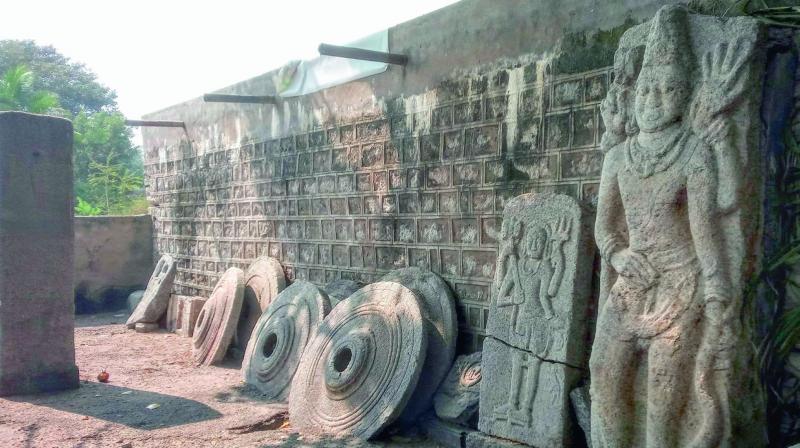Nyaya Lingam is a role model for harmony
Someshwaraswami temple at Kolanupaka was a venue to settle disputes.

Hyderabad: The Nyaya Lingam in the Pramana Mandapam, located in front of the ancient Sri Chandikamba Sametha Someshwaraswami temple at Kolanupaka in Aler mandal of Yadadri-Bhuvanagiri district, was once a venue for settling disputes among the people, apart from fulfilling their wishes. Kolanupaka or Kollipaka is a famous Jain pilgrim centre housing a 2,000-year-old Jain Mahavira temple having intricate carvings.
The Sri Chandikamba Sametha Someshwaraswami temple is part of ancient Trilinga Desam comprising famous Shiva temples the others being the Sri Kolanupaka Swayambhu Someshwaraswami Lingam, Srisaila Mallikarjunaswami lingam in Kurnool district and the Draksharamam (Bheemanath) lingam in West Godavari district of Andhra Pradesh.
Someshwaraswami is an avatar of Lord Shiva in the form of the swayambhu lingam, which is cracked. It is believed Adi Jagadguru Renukacharya emerged from the lingam.
Renukacharya was not only the founder of the Veerashaiva sect, he fought for emancipation of women and provided them equal rights in all spheres of life including entry into temples.
Veerashaiva Lingayats from Telangana state, Andhra Pradesh, Karnataka, Maharashtra and other states visit the temple in large numbers and celebrate Renukacharya jayanti annually. Kolanupaka is located 80 km from Hyderabad, 6 km after Aler on the Hyderabad-Warangal highway. It is 22 km from the famed Yadadri, abode of Lord Laxminarasimhaswami, which is being given a major facelift by Chief Minister K. Chandrasekhar Rao.
The Kolanupaka temple is also slated for a major renovation but the work is pending. Archaeology and museums department director N.R. Visalatchy has prepared proposals seeking Rs 6 crore to restore the two 11th century AD temples, but it is yet to take off. Some minor works are taken up occasionally.
“Historical evidence states Kolanupaka was the second capital of the Kalyani Chalukyas during the 11th century. At that time, the village was a great Shiva pilgrimage centre and a religious centre of Jains, ranking among the other great Jain centres of South India,” said Mr Gangula Srinivas, sarpanch of Kolanupaka.
According to Jagdev Hiremath, president, Rashtra Veerashaiva Dharma Prachara Sangham, who organises the Renukacharya jayanti at the temple premises annually, the temple is much older than 11th century going by puranas and was developed in phases by various rulers. “Above all, the temple is a role model for harmony of various communities,” Mr Hiremath said.
It is said that Lord Rama, and the saints Narada and Agastya worshipped at this temple.
Mr P. Nagaraju, assistant director, department of archaeology and museums, has identified about 100 sculptures and inscriptions belonging to Hinduism and Jainism around Kolanupaka.
The Someshwara temple complex has several temples, idols, artifacts. There is an archaeological department sculptural gallery with ancient sculptures, stone carvings which needs immediate attention. the complex houses a pilgrims’ rest house and the Sri Someshwara Renuka Yatri Nivas.
The temples in the complex include those of Sri Renukacharya, Sri Mallikarjunaswami, Chandeshwari, Kundamamba, Kotilingeswaraswami, Kala Bhairaviswami, Anjaneya, Rudranidraswami, Veerabhadraswami, Kumaraswami and the Ekadasharudrula temple.
Besides the temples, the Kolanupaka also houses the mutts of 18 castes, which is unheard in other temples. They are Pedda Matam, Gaundla Matam, Kurva Matam, Medari Matam, Golla Matam, Padmashali Matam, Komati Matam, Kapula Matam, Madiga Matam, Mala Matam, Ganiga Matam, Meru Matam, Sangari Matam, Sakali Matam, Nakasha Matam, Vadrangi Matam, Mamaya Matam, and Dwala Matam. Some more matams were subsequently established and there was division of labour.
Some of the famed sculptures of Hindus and Jains at Kolanupaka include the manasthambha (victory pillar) of Tribhuvanamalla with an inscription mentioning the date 1076-1127 AD, and a Kodanda Rama statue of the 12th Century Vijayanagara period.
The temple has Ganapathi and Nataraja idols and Mahavir in yoga posture of the Chalukya period in the 12th century.
From the 13th century Kalyani Chalukya period are the Virangal (elopement) statue, the idols of Mahishasuramardani and Kosthapanjara with Uma Maheswara. The village houses the idols of Chamundi and Govinda of the Kakatiya period from the 13th century, as also statues of Nandi and Vajrapani. Artifacts from the Chalukya and Kakatiya eras are displayed at the museum which is considered a great site for researchers with more than 100 images.

